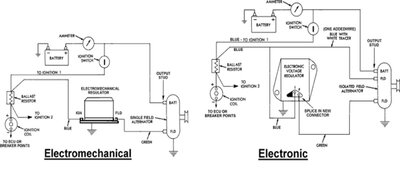- Local time
- 6:07 PM
- Joined
- Jan 14, 2009
- Messages
- 2,266
- Reaction score
- 1,896
- Location
- Shoreline, Washington
Generally, electronic regulators are more accurate/reliable than their mechanical counterparts. There are direct replacement electronic versions on the market for the pre-’70 applications. The square-back alternators were designed for the 1970 and later factory electronic regulation, have two field connections “isolated” from the alternator case. They can be modified for use with pre-70 regulators and there is significant benefit to running the later higher output alternators, more charge current available at idle.
There are plenty of threads here that address what can go wrong when you mismatch these alternators & regulators.
To be clear, the no start condition described here has nothing to with the charging system.
There are plenty of threads here that address what can go wrong when you mismatch these alternators & regulators.
To be clear, the no start condition described here has nothing to with the charging system.
Last edited:

















